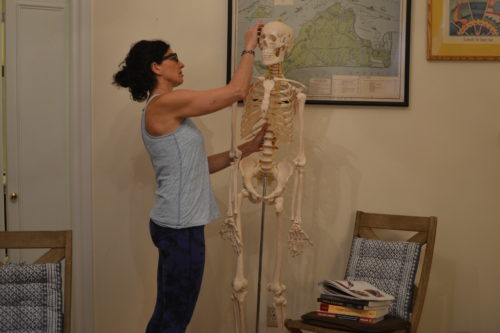
I went to dinner the other night with some friends and as often does, the topic of “staying healthy” came up. The group knew I was a yoga teacher so the conversation shifted specifically to “what you need to do to stay healthy” in terms of the movement systems of the body (bones, muscles, joints). I always love when this comes up because I get to hear all the things that I see on social media but repeated to me by people in person. Things like:
” You need to get a standing desk.”
” You need to get this new contraption where you can lie on your couch and your laptop is right in front of you.”
” Lunges are the best way to keep your body healthy.”Â
” 20 minutes of movement once a day is really the secret.”Â
I get it. We are all looking for the ONE thing. We don’t have a lot of time. We want to maximize the impact of whatever it is we do. We also have the additional challenge of getting a LOT of information tossed at us by people in the industry telling us what we should do. It’s confusing and the results vary from person to person, further complicating our own decision about what we should do.
Well, I hate to break it to you, but there is no ONE thing. You might laugh, because you might think (or you might have heard) that yoga is the ONE thing you should do every day in order to keep your musculoskeletal system healthy (along with your nervous system and other systems of the body). And you might also think that I’d be a proponent of that because I’m a yoga teacher and have been for almost 15 years.
I think it’s because of my background in anatomy, physical rehabilitation and exercise science that I’ve decided that even yoga as your primary mode of exercise isn’t the best way to keep your body healthy. ( It also comes from talking to Physical therapists about some of the problems they see in long time yoga only practitioners). My experience shows me that variety is the best thing you can do for your body. Yes, of course, yoga is a wonderful form of exercise, but so is walking, running, working out with weights, using foam rollers, massage balls, pilates, Jazzercise, dancing, golf… the list goes on and on. My general rule of thumb now is that every day should involve some form of exercise and self care. Think of it as a combination of something physical plus something more meditative. Yoga of course, provides both right in one “workout.” But what about a run followed by foam rolling? Or a long walk on the beach or a hike (which is both meditative and physical). Or a seated meditation followed by a gym workout? Or some yoga to prepare the body and then 9 holes of golf?
Rather than looking for the ONE thing that will keep your body healthy, think about adding some kind of exercise activity into each day. it doesn’t need to be a knock down sweatfest; it might be a brisk walk. Or it could be something more strenuous. But whatever it is, make it specific. I walk all the time around Boston because I hardly ever use my car but I don’t really call that “exercise.” Sure, it keeps the body moving but a exercise session is just that; something specific you do to impact your health. While it is important to work movement into your day, it’s also important to make time, to carve out time, for exercise.
From an anatomical standpoint, I like to use two rules of thumb:
- Do the opposite
- Move the body in all planes, regularly
“Do the opposite” means that if you do one action a lot, take time to do the opposite. The most common example of this is hunching over the phone and computer. We all do this so much that it’s helpful to do something in the opposite direction when it comes to the cervical spine/neck. While standing upright is a better posture, try things that strengthen the neck extensors, so things like holding Plank Pose or Dolphin Plank. Think about movements that take the back into extension, so poses like Bridge or Wheel. Even think about taking an exercise ball and laying back on it, as if in Wheel, but in a more supported fashion.
“Move the body in all planes, regularly” refers to the importances of moving front to back, side to side and rotating/twisting as well. I’ve written past blogs about this from an anatomical perspective but for now, let’s just keep it simple and say that it’s helpful to give the body variety in movements. So, if you golf a lot, that involves a lot of rotation and hunching over the ground. Take time to do spinal and hip extension ( the exercises above as well as lunges). If you’re a runner, that involves a lot of front to back movements, so work in some side to side exercises (side lunges, for instance).
If you’re looking for a yoga workout you can do at home, my class on Vimeo is just $10. You download it and practice whenever you want. It’s also loaded with anatomical tips so you might pick up a few things about anatomy along the way too.
Thanks for reading!Â
